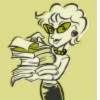 Henderson, Kathy. Jane Ray (Ill.) 2006. LUGALBANDA: THE BOY WHO GOT CAUGHT UP IN A WAR. Cambridge, MA: Candlewick Press. ISBN 0-763-62782-8
Henderson, Kathy. Jane Ray (Ill.) 2006. LUGALBANDA: THE BOY WHO GOT CAUGHT UP IN A WAR. Cambridge, MA: Candlewick Press. ISBN 0-763-62782-8In this 2007 Aesop award winning book, Kathy Henderson brings to light a piece of history from a part of the world about which Americans are so much in the dark. The story of Lugalbanda is an “epic tale from ancient Iraq.” Each of the characters is imbued with qualities which makes him believable. Henderson ensures that readers will be sympathetic to Lugalbanda, his brothers and the king by showing their human sides. Lugalbanda’s brothers, each a commander in the army, “bowed down with grief” as they were forced to leave their young brother behind. Lugalbanda showed his humility and intelligence as he won over the ferocious Anzu bird by caring for its chick. Even the king, through Henderson’s careful word choice, proved to be compassionate by ultimately putting the safe return of his army above the possible spoils of war. Ray’s illustrations add as much to the story as the text. When Lugalbanda was ill, his eyes were colorless and all seven brothers’ cried by his side. The Lullubu Mountains were as barren as the text describes. Both author and illustrator attempt to authentically represent the culture in which this story takes place. Geographic locations, maps, skin tone, hair color, eye shape—all are indicative of the area now known as Iraq. (Although the seven brothers appear to be septuplets!) The text includes an informative prologue and end notes which give the reader a 5000-year old history lesson. The origin of Lugalbanda is a fascinating story in itself.
LUGALBANDA is appropriate as a multi-sitting read aloud or for individual reading and is highly recommended for readers ages 8 years and older.



